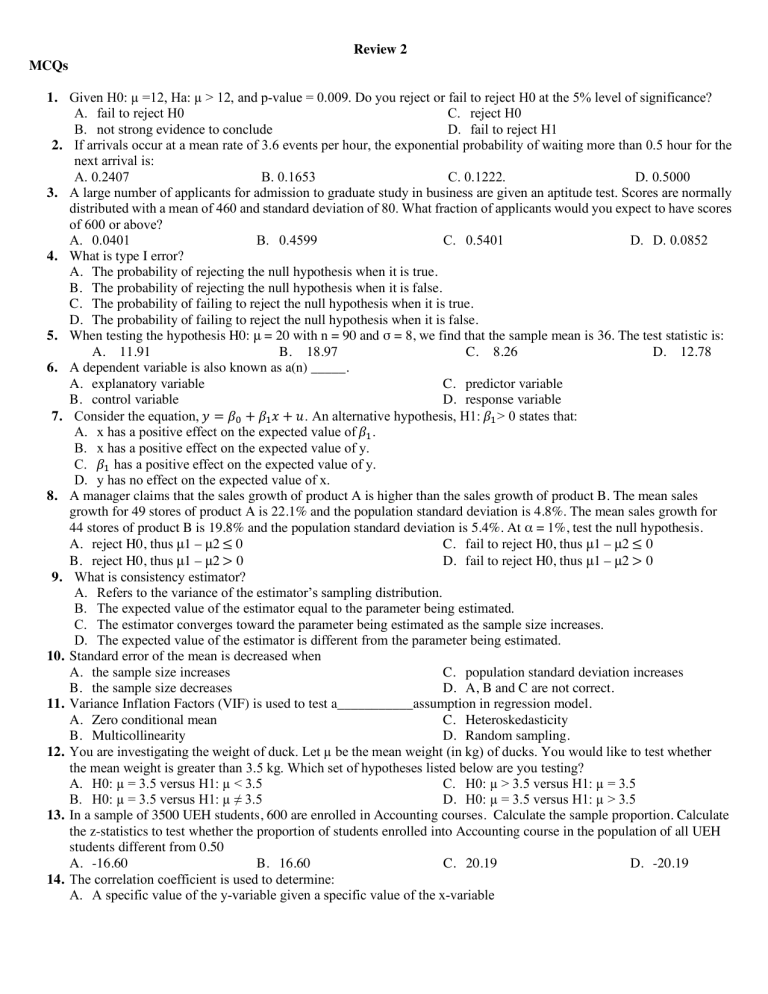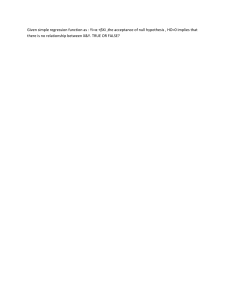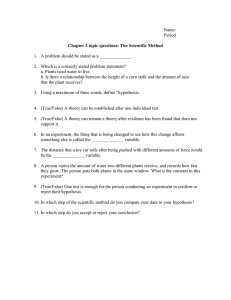
Review 2 MCQs 1. Given H0: µ =12, Ha: µ > 12, and p-value = 0.009. Do you reject or fail to reject H0 at the 5% level of significance? A. fail to reject H0 C. reject H0 B. not strong evidence to conclude D. fail to reject H1 2. If arrivals occur at a mean rate of 3.6 events per hour, the exponential probability of waiting more than 0.5 hour for the next arrival is: A. 0.2407 B. 0.1653 C. 0.1222. D. 0.5000 3. A large number of applicants for admission to graduate study in business are given an aptitude test. Scores are normally distributed with a mean of 460 and standard deviation of 80. What fraction of applicants would you expect to have scores of 600 or above? A. 0.0401 B. 0.4599 C. 0.5401 D. D. 0.0852 4. What is type I error? A. The probability of rejecting the null hypothesis when it is true. B. The probability of rejecting the null hypothesis when it is false. C. The probability of failing to reject the null hypothesis when it is true. D. The probability of failing to reject the null hypothesis when it is false. 5. When testing the hypothesis H0: μ = 20 with n = 90 and σ = 8, we find that the sample mean is 36. The test statistic is: A. 11.91 B. 18.97 C. 8.26 D. 12.78 6. A dependent variable is also known as a(n) _____. A. explanatory variable C. predictor variable B. control variable D. response variable 7. Consider the equation, 𝑦 = 𝛽$ + 𝛽& 𝑥 + 𝑢. An alternative hypothesis, H1: 𝛽& > 0 states that: A. x has a positive effect on the expected value of 𝛽& . B. x has a positive effect on the expected value of y. C. 𝛽& has a positive effect on the expected value of y. D. y has no effect on the expected value of x. 8. A manager claims that the sales growth of product A is higher than the sales growth of product B. The mean sales growth for 49 stores of product A is 22.1% and the population standard deviation is 4.8%. The mean sales growth for 44 stores of product B is 19.8% and the population standard deviation is 5.4%. At α = 1%, test the null hypothesis. A. reject H0, thus μ1 – μ2 ≤ 0 C. fail to reject H0, thus μ1 – μ2 ≤ 0 B. reject H0, thus μ1 – μ2 > 0 D. fail to reject H0, thus μ1 – μ2 > 0 9. What is consistency estimator? A. Refers to the variance of the estimator’s sampling distribution. B. The expected value of the estimator equal to the parameter being estimated. C. The estimator converges toward the parameter being estimated as the sample size increases. D. The expected value of the estimator is different from the parameter being estimated. 10. Standard error of the mean is decreased when A. the sample size increases C. population standard deviation increases B. the sample size decreases D. A, B and C are not correct. 11. Variance Inflation Factors (VIF) is used to test a___________assumption in regression model. A. Zero conditional mean C. Heteroskedasticity B. Multicollinearity D. Random sampling. 12. You are investigating the weight of duck. Let µ be the mean weight (in kg) of ducks. You would like to test whether the mean weight is greater than 3.5 kg. Which set of hypotheses listed below are you testing? A. H0: µ = 3.5 versus H1: µ < 3.5 C. H0: µ > 3.5 versus H1: µ = 3.5 B. H0: µ = 3.5 versus H1: µ ≠ 3.5 D. H0: µ = 3.5 versus H1: µ > 3.5 13. In a sample of 3500 UEH students, 600 are enrolled in Accounting courses. Calculate the sample proportion. Calculate the z-statistics to test whether the proportion of students enrolled into Accounting course in the population of all UEH students different from 0.50 A. -16.60 B. 16.60 C. 20.19 D. -20.19 14. The correlation coefficient is used to determine: A. A specific value of the y-variable given a specific value of the x-variable B. A specific value of the x-variable given a specific value of the y-variable C. The strength of the relationship between the x and y variables D. None of these 15. In a regression analysis with Y is a dependent variable, X is an independent variable, the goodness of fit (coefficient of determination) =40% means: A. Y can explain 40% total variations in X B. X can explain 40% total variations in Y C. Residuals can explain 40% total variations in Y D. Residuals can explain 40% total variations in X 16. Suppose the time to complete an EQ test varies with a uniform distribution between 55 and 155 minutes. What is the probability that a person completes the test between 70 and 100 minutes? A. 10% B. 20% C. 30% D. 40% 17. For a left-sided test and significance level 𝛼, we reject the null hypothesis in favor of alternative hypothesis if A. 𝑧 𝑠𝑡𝑎𝑡𝑖𝑠𝑡𝑖𝑐𝑠 < −𝑐𝑟𝑖𝑡𝑖𝑐𝑎𝑙 𝑣𝑎𝑙𝑢𝑒 𝑧9 C. 𝑧 𝑠𝑡𝑎𝑡𝑖𝑠𝑡𝑖𝑐𝑠 < −𝑐𝑟𝑖𝑡𝑖𝑐𝑎𝑙 𝑣𝑎𝑙𝑢𝑒 𝑧9/; B. 𝑧 𝑠𝑡𝑎𝑡𝑖𝑠𝑡𝑖𝑐𝑠 > 𝑐𝑟𝑖𝑡𝑖𝑐𝑎𝑙 𝑣𝑎𝑙𝑢𝑒 𝑧9 D. |𝑧 𝑠𝑡𝑎𝑡𝑖𝑠𝑡𝑖𝑐𝑠| > 𝑐𝑟𝑖𝑡𝑖𝑐𝑎𝑙 𝑣𝑎𝑙𝑢𝑒 𝑧9/; 18. For a two-sided test and significance level 𝛼, we reject the null hypothesis in favor of alternative hypothesis if A. 𝑧 𝑠𝑡𝑎𝑡𝑖𝑠𝑡𝑖𝑐𝑠 < −𝑐𝑟𝑖𝑡𝑖𝑐𝑎𝑙 𝑣𝑎𝑙𝑢𝑒 𝑧9 C. 𝑧 𝑠𝑡𝑎𝑡𝑖𝑠𝑡𝑖𝑐𝑠 < −𝑐𝑟𝑖𝑡𝑖𝑐𝑎𝑙 𝑣𝑎𝑙𝑢𝑒 𝑧9/; B. |𝑧 𝑠𝑡𝑎𝑡𝑖𝑠𝑡𝑖𝑐𝑠| > 𝑐𝑟𝑖𝑡𝑖𝑐𝑎𝑙 𝑣𝑎𝑙𝑢𝑒 𝑧9 D. |𝑧 𝑠𝑡𝑎𝑡𝑖𝑠𝑡𝑖𝑐𝑠| > 𝑐𝑟𝑖𝑡𝑖𝑐𝑎𝑙 𝑣𝑎𝑙𝑢𝑒 𝑧9/; 19. A random sample of 25 observations have a mean of X = 150. Assume that the data follows a normal distribution with unknown mean m and standard deviation s = 10. A 90% confidence interval for mean is A. 150 ± 2.00. B. 150 ± 3.29. C. 150 ± 3.42. D. 150 ± 16.45. 20. The value of R2 always _____. A. lies below 0 C. lies between 0 and 1 B. lies above 1 D. lies between 1 and 1.5 21. Assume that known population distribution, the rejection region for testing H0: µ = 200 vs. H1: µ ≠ 200, at the 0.05 level of significance is: A. | z | < 0.95 B. | z | > 1.96 C. z > 1.65 D. z < 2.33 22. In the simple linear regression model, the y-intercept represents the: A. change in y per unit change in x. C. value of y when x = 0. B. change in x per unit change in y. D. value of x when y = 0. 23. For the following multiple regression model: 𝑦== 0.5 − 5x1 + 2x2 + 0.5x3, a unit increase in x1, holding x2 and x3 constant, results in: A. an increase of 5 units on average in the value of y B. a decrease of 5 units on average in the value of y. C. an increase of 4.5 units in the value of y. D. None of these choices. 24. As the degrees of freedom for the t distribution increase, the distribution approaches A. value of zero for the mean. C. The normal distribution. B. The t distribution D. The binomial distribution 25. Assume that the population follows normal distribution with known SD. What is the equation to calculate test statistic? >̅ @A >̅ @A >̅ @A >̅ @A A. 𝑧 = B B. 𝑧 = E C. 𝑡 = B D. 𝑡 = E √D √D √D 26. If a change in variable x causes a change in variable y, variable x is called the _____. A. dependent variable B. explained variable √D C. explanatory variable D. response variable 27. If xi and yi are positively correlated in the sample then the estimated slope is _____. A. less than zero B. greater than C. equal to zero D. equal to one zero 28. If the total sum of squares (SST) in a regression equation is 81, and the residual sum of squares (SSR) is 25, what is the explained sum of squares (SSE)? A. 64 B. 56 C. 32 D. 18 29. There are n-1 degrees of freedom in Ordinary Least Square residuals. 30. The general t statistic can be written as: a. t= A. True B. False b. t = c. t= d. t= 31. Which statement is incorrect?. A. If p = .50 and n = 100, the standard error of the sample proportion is .05. B. In a sample size calculation for estimating π, it is conservative to assume π = .50. C. If n = 250 and p = .06, we cannot assume normality in a confidence interval for π. 32. The regression equation Salary = 45,000 + 1500 YearsExperience + 2800 YearsCollege describes employee salaries at Terminus Fissile Labs. The standard error is 2500. Lars has 15 years' experience and 4 years of college. His salary is $70,500. If this regression is valid, we conclude that: A. Lars is underpaid, but is not an outlier. B. Lars is underpaid, and his salary is an outlier. C. Lars is overpaid, but is not an outlier. D. Lars is overpaid, and his salary is an outlier. 33. Guidelines for the Jolly Blue Giant Health Insurance Company say that the average hospitalization for a triple hernia operation should not exceed 30 hours. A diligent auditor studied records of 15 randomly chosen triple hernia operations at Hackmore Hospital and found a mean hospital stay of 40 hours with a standard deviation of 20 hours. "Aha!" she cried, "the average stay exceeds the guideline. At α = .025, the critical value for a right-tailed test of her hypothesis is: A. 1.753 B. 2.131 C. 2.145 D. 1.960 34. Which of the options below would increase the likelihood of rejecting the hypothesis that an individual slope coefficient equals zero? A. An increased standard error for that slope coefficient. B. A reduced t statistic for that slope coefficient. C. A decreased F statistic for the regression. D. A greater value for the ratio of the coefficient to its standard error. 34. For the following multiple regression model: 𝑦== 1 − 5x, what is the residual for the point (1,8) ? A. 0 B. 4 C. 12 D. -5 35. For a given sample size, when we increase the probability of a Type I error, the probability of a Type II error: A. remains unchanged. B. increases. C. decreases. D. is impossible to determine without more information. 36. In a multiple regression analysis, if the model provides a poor fit, this indicates that: A. the sum of squares for error will be large. B. the standard error of estimate will be large. c. the coefficient of determination will be close to zero D. All of these choices are true. 37. In regression analysis, what is the primary purpose of using dummy variables? A.To represent categorical data numerically B. To increase the model complexity C. To eliminate multicollinearity D. To standardize the data 38. As a general rule, the normal distribution is used to approximate the sampling distribution of the sample proportion only if: A. the sample size n is greater than 30. B. the population proportion p is close to 0.50. C. the underlying population is normal. D. np and n(1 − p) are both greater than or equal to 10. 39. If you increase the confidence level in a confidence interval, what happens to the margin of error? A. It decreases B. It increases. C. It remains unchanged. D.It depends on the sample size. 40. What is the dependent variable in simple linear regression? A. The variable being predicted. B. The variable used for prediction C. The variable assumed to cause changes in the independent variable D.There is no dependent variable in simple regression LONG QUESTIONS R2.1. The time to watching TV of 400 people was recorded. Within the group of people being studied, the probability that a person chosen at random was 30 years old older is 0,3 and the probability of a watching time less than 30 minutes per day is 0,7. a. How many people who are 30 years old or older? b. How many people who have a watching time of less than 30 minutes per day? c. If age and watching time are independent events, calculate the number of people 30 years old and older with a watching time of less than 30 mins per day. d. Complete the cross table below. Watching time <30 Watching time >30 Total mins mins <30 years old >= 30 years old 400 R2.2 The time that it takes person A to go to school is approximately normal with mean 40 minutes and standard deviation 15 minutes. a. Draw a normal distribution curve carefully, making sure to show the mean and standard deviation. b. What is the probability that A goes to school in less than 20 minutes? c. What is the chance that A spends more than an hour on the street to go to school? d. What is the probability that A spends between 30 and 45 minutes to go to school? R2.3 A business manager is curious about how long it typically takes to train new employees. Assume that the average training time spent by 200 employees, chosen at random, is 16.2 days, and that the standard variation of that time is 3.6 days. a. Find a confidence interval of 95% for the mean of training time. b. At 5% significance level, test the hypothesis that the training time is different from 15 days. c. At 1% significance level, test the hypothesis that the training time is greater than 15.6 days. d. Using p-value, test the hypothesis that the training time is less than 16.5 days at 5% significance level.




